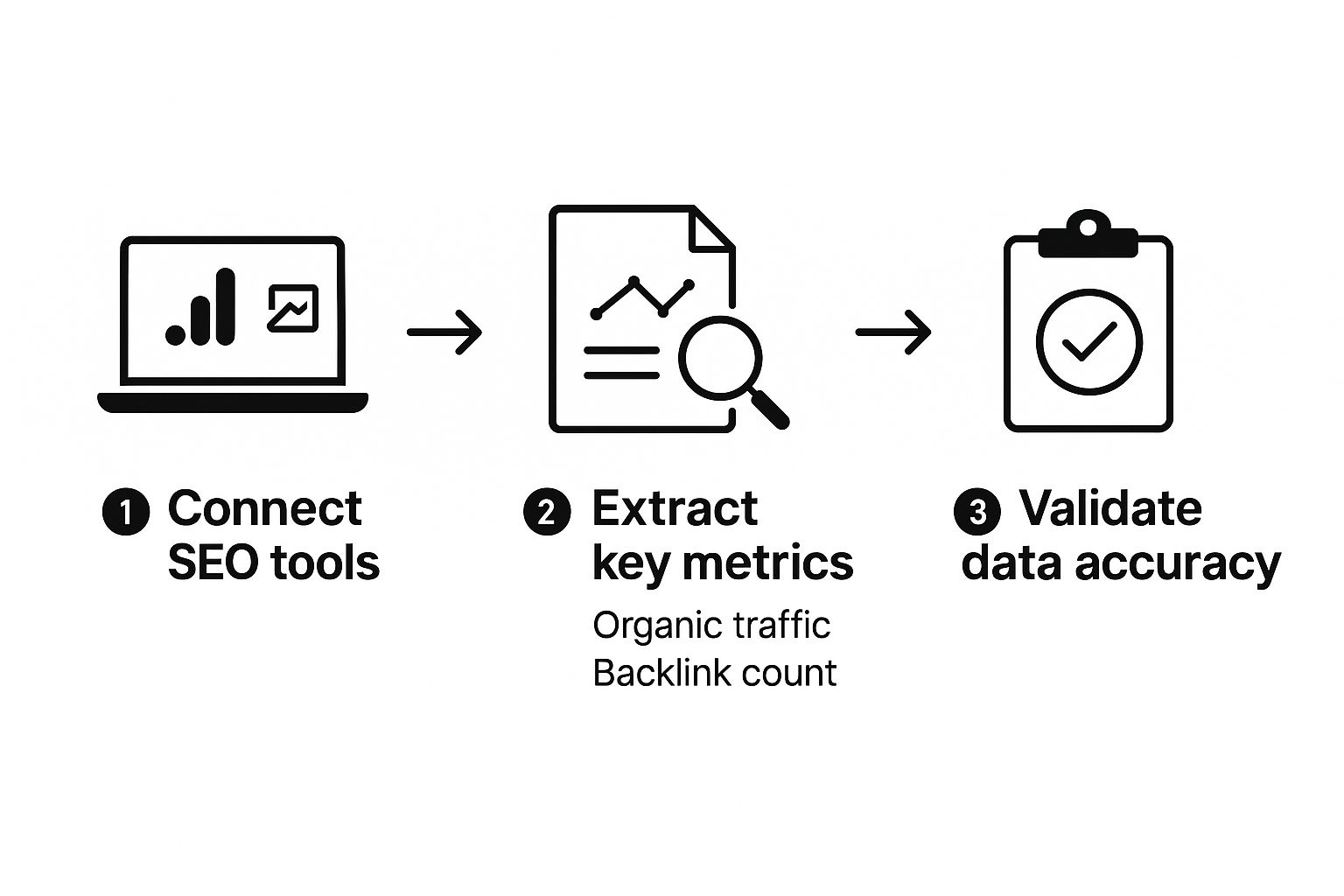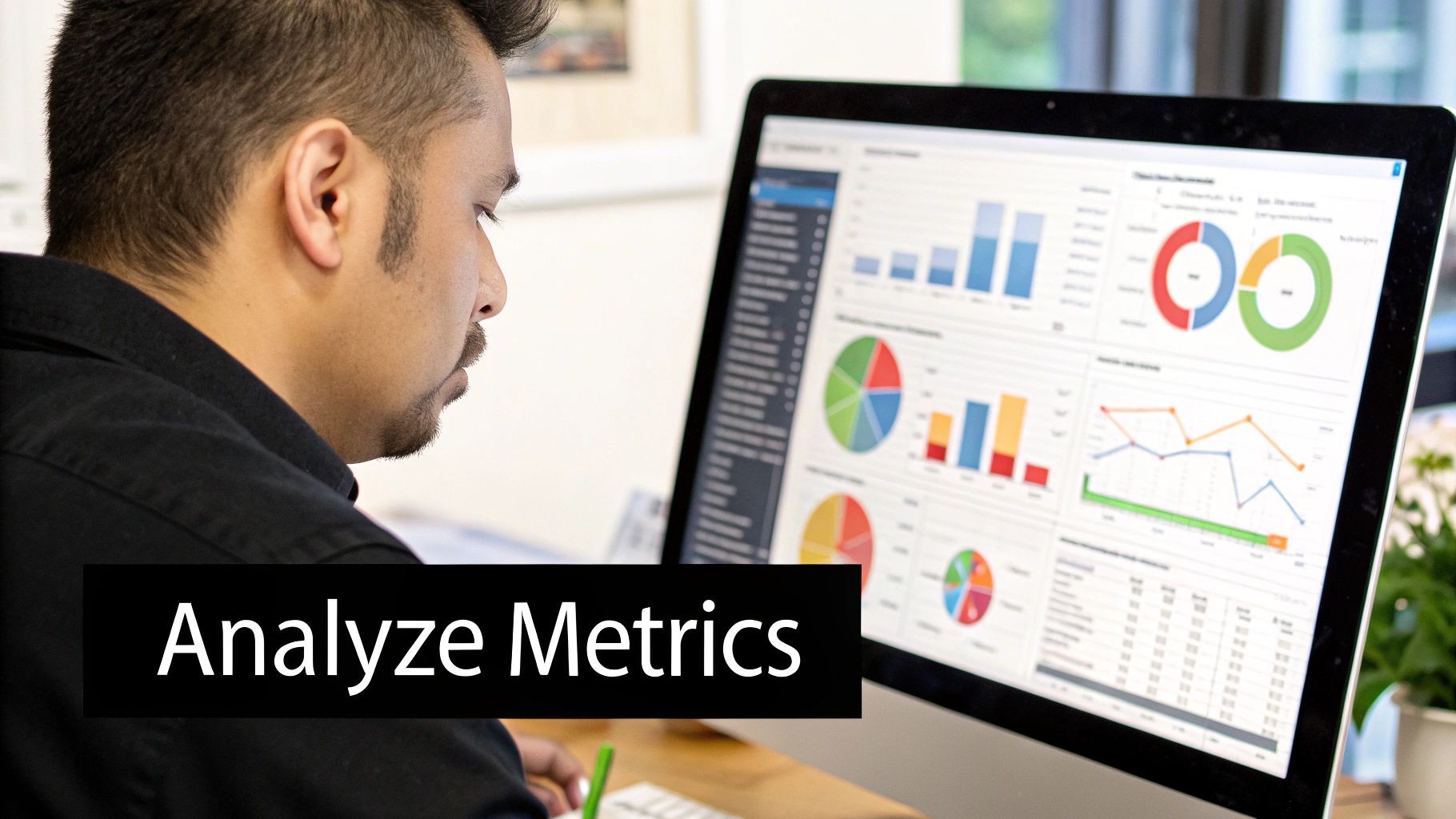When it comes to SEO reports, the real goal is to turn a pile of raw data into a clear, compelling story. It’s about drawing a straight line from your optimization efforts directly to tangible business results. This means carefully picking the right metrics, visualizing how performance is trending, and, most importantly, adding your expert analysis to explain what happened, why it mattered, and what we should do next.
A truly great report isn't just a data dump. It's a strategic tool that helps everyone make smarter decisions.
Moving Beyond Data Dumps to Actionable Insights
Let's get one thing straight: a fantastic SEO report is not a spreadsheet you exported from a tool. It’s a strategic narrative that proves how your SEO work is fueling business growth. I’ve seen the most successful marketers nail this by focusing on storytelling instead of just listing off a bunch of numbers.
Your report should be clean, visually engaging, and directly answer the big questions your stakeholders have. Are they focused on new leads? Revenue growth? Better brand visibility? A good report speaks their language and gets right to the point. This requires a shift in mindset—stop reporting metrics and start communicating real-world impact.
From Numbers to Narrative
Your mission is to make your reports a catalyst for smart decisions. Every chart, every metric, every single number needs to serve a purpose in the larger story of your SEO campaign's journey.
For instance, don't just state that organic traffic went up by 20%. That’s a start, but it’s not the full story. Instead, explain how it happened: "Our organic traffic jumped by 20% this month, driven primarily by three new blog posts that now rank on the first page for their target keywords. This directly contributed to a 15% increase in qualified marketing leads from our blog." See the difference? One is a stat; the other is a win.
An SEO report without analysis is just noise. The real value comes from adding context—the "why" behind the data—which turns a summary into a strategic document that guides future actions.
To get this right, you have to stay on top of current SEO trends and insights. This wider context is crucial for explaining performance swings and spotting fresh opportunities before your competitors do.
The Business Case for Better Reporting
This narrative-driven approach isn't just a "nice-to-have"—it’s essential. SEO continues to be a cornerstone of marketing strategies everywhere. The 2025 State of SEO Survey revealed that a staggering 91% of marketers confirmed SEO had a positive impact on their website performance and marketing goals in 2024.
On top of that, organic search drove about one-third (33%) of all website traffic across major industries. It’s not just a line item; it’s a vital channel for growth. You can dive deeper into these stats and more on Clutch.co.
This direct link to business outcomes is precisely why a story-focused report is so powerful. It demonstrates the value of your hard work in a language that executives and clients actually understand: results.
To make building these reports easier, you might want to explore some dedicated tools. We've put together a guide on the best SEO reporting software to help you find the right fit.
Key Elements of an Impactful SEO Report
Turning data into a strategic asset requires a few core components. Think of these as the building blocks of a report that not only informs but also persuades and guides. The table below breaks down what truly matters.
| Component | What It Is | Why It Matters |
|---|---|---|
| Executive Summary | A brief overview of key wins, challenges, and next steps, written in plain language. | It respects stakeholders' time and immediately communicates the most critical information. |
| Performance vs. Goals | A clear comparison of current metrics against pre-defined KPIs and business objectives. | It directly answers the question: "Are we succeeding?" and keeps everyone aligned. |
| Key Metric Deep Dive | A focused look at a few crucial metrics (e.g., organic traffic, conversions, keyword rankings). | It provides the evidence for the summary, showing the data behind the results. |
| Context & Analysis | Your expert interpretation of the data—the "why" behind the numbers. | This is where you add value. It transforms data into insight and demonstrates your expertise. |
| Action Plan | A list of concrete, prioritized next steps based on the report's findings. | It makes the report forward-looking and ensures that insights lead to action. |
Ultimately, a report that incorporates these elements becomes more than just a monthly update. It’s a roadmap for future success, reinforcing the value of your SEO program and securing buy-in for what comes next.
Choosing Metrics That Truly Matter for Your Business

Before you even touch a reporting tool, we need to talk about what you're actually going to report on. This is where most SEO reports go wrong. They get filled with vanity metrics—impressive-looking numbers that don't actually mean anything for the business's bottom line.
A truly valuable report cuts through that noise. It focuses on Key Performance Indicators (KPIs) that connect directly to tangible business objectives. A report for a local plumber, for example, will look completely different than one for a national SaaS company. The plumber wants to see local map rankings and phone calls, while the software company is laser-focused on trial sign-ups. Getting this right from the start is what makes your report indispensable.
Primary vs. Diagnostic Metrics: Know the Difference
One of the biggest mistakes I see is lumping all metrics together. This turns a strategic report into a confusing data dump. The key is to separate your primary, bottom-line metrics from the secondary, diagnostic ones.
- Primary Metrics: These are the big-ticket items that directly reflect business success. Think revenue from organic search, qualified leads, or e-commerce sales. They answer the million-dollar question: "Is our SEO making us money?"
- Diagnostic Metrics: These are the supporting characters. They tell you why your primary metrics are moving up or down. This category includes things like keyword rankings, click-through rates (CTR), backlink growth, and organic traffic. They provide the context behind the results.
For instance, if you see a sudden drop in organic conversions (a primary metric), you can dig into your diagnostic metrics and discover it was caused by a ranking drop for a few high-intent keywords. This framework turns your report from a list of numbers into a clear, compelling story.
Match Your KPIs to the Business Model
There’s no such thing as a one-size-fits-all list of SEO KPIs. If you’re using one, your report is probably falling flat. You have to customize your metrics based on how the business actually operates and makes money.
A detailed Local SEO Service Business Guide can be a goldmine for finding the right metrics for local businesses. For other models, here are a few ideas to get you started:
- E-commerce Store: You should be tracking organic revenue, conversion rates for top landing pages, and rankings for specific product keywords.
- SaaS Company: Focus on organic trial sign-ups, demo requests, and visibility for non-branded keywords that attract new customers.
- Lead Generation Site (like a local contractor): The money is in organic form submissions, calls from the Google Business Profile, and rankings in your key service areas.
Focusing on these kinds of outcomes is what it's all about. After all, SEO is a core driver of business growth. A staggering 53.3% of all website traffic comes from organic search, making it the most dominant traffic source out there.
Even with its importance, the debate over which metrics matter most continues. Only about 9.2% of SEOs consider CTR their top metric. This just proves that you need to pick KPIs that matter to your business and your goals, not just follow the latest industry trend. The best reports are the ones that draw a straight line between SEO activities and the results that make stakeholders sit up and take notice.
Building Your Automated Reporting Dashboard
So, you've locked in your core KPIs. Fantastic. Now comes the part where we stop drowning in spreadsheets and start building something that actually works for us: a centralized, automated dashboard. The whole point is to get this thing set up so you can refresh it in minutes, not waste hours manually pulling data. This frees you up to do the real work—analyzing the data and figuring out what to do next.
I’m a big fan of using Google Looker Studio for this, especially when you're starting out. It’s free, incredibly powerful, and it plays nicely with the tools we all use day in and day out, like Google Analytics 4 and Google Search Console. The basic idea is simple: connect your data sources once, design your report visuals, and then let the automation handle the grunt work every month.
This first step—connecting your data—is the foundation for everything else.

Think of it like plumbing. You have to connect the pipes correctly before any water (or in our case, data) can flow through. Getting this right ensures your report is accurate and trustworthy from the get-go.
Essential Tools for SEO Data Collection
Before you can build anything, you need the raw materials. Your dashboard is only as good as the data feeding it. For a solid SEO report, you'll be pulling from a few key places.
| Tool | Primary Use | Key Metrics to Pull |
|---|---|---|
| Google Analytics 4 | On-site user behavior | Organic Sessions, Conversions, Engagement Rate, New Users |
| Google Search Console | Organic search performance | Clicks, Impressions, Average Position, Click-Through Rate (CTR) |
| Ahrefs / Semrush | Off-page & competitive analysis | Domain Authority, Backlink Growth, Keyword Rankings, Competitor Traffic |
These platforms represent your "sources of truth." You'll want to connect them directly to Looker Studio using its built-in "connectors." These connectors are just bridges that let Looker Studio talk to your other tools, pull the latest data automatically, and keep your dashboard up to date.
Designing Your First Visualizations
With data flowing into your dashboard, it's time for the fun part: bringing it to life with charts and graphs. The biggest mistake I see people make here is trying to cram every possible metric onto one page. Don't do it. A cluttered dashboard is a useless one.
Instead, focus on creating clean, simple visuals that directly represent the KPIs you decided on earlier. Think about telling a story.
Start with the headline numbers. Use big, bold scorecards at the top for your most important metrics—things like Total Organic Conversions or Organic Sessions. This gives anyone looking at the report an instant snapshot of performance.
From there, use line charts to visualize trends over time. How did organic traffic look this quarter compared to last? Are keyword impressions trending up? Bar charts are perfect for comparisons, like seeing which landing pages are bringing in the most traffic.
The real magic of a dashboard isn't just showing numbers; it's revealing the relationship between them. For instance, place your organic traffic chart right next to your conversions chart. This instantly creates a visual link between website visits and actual business goals.
Ultimately, building a master dashboard template is a one-time investment that will pay dividends every single month. If you want more tips on efficiency, this is a great read on how to write reports faster, which covers how smart templates and automation can be a game-changer. It makes creating insightful, professional SEO reports easier than ever.
Telling a Story with Context and Analysis

A dashboard packed with metrics is just noise. It’s your job to connect the dots and turn that noise into a story your client or boss can actually understand. Without your analysis, any report is guaranteed to fail the "So what?" test.
This is where your real value as an SEO pro comes in. You have to provide the "why" behind the numbers. That’s what turns a boring data dump into a strategic tool that guides the next move. Don't just show a dip in traffic; explain that it's a predictable seasonal trend for their industry. Don’t just point out a ranking jump; tie it directly to that link-building campaign you just wrapped up.
Adding this analytical layer is what separates a rookie report from an expert one. It proves you get the bigger picture—the business context—and can draw a straight line from your actions to their results.
How to Structure Your Analysis
You need to make your analysis easy to digest. I always start with a quick, punchy executive summary right at the top. Just a few sentences covering the highlights: the big wins, the key challenges, and what we're doing about it next.
After the summary, I break down the analysis into sections that line up with our main goals. This way, the CEO can find what they care about, and the content manager can find what's relevant to them, all without getting lost.
- Overall Performance: Kick things off with the high-level trends. Did organic traffic grow month-over-month? How are we pacing against our conversion goals? This is the 30,000-foot view.
- Keyword & Content Insights: This is where you get specific. Talk about important keyword movements. Did that new pillar page finally start ranking for its target term? Did we lose ground on a core service page to a new competitor?
- Technical Health: Note any critical technical fixes you made. For example, if you improved site speed, show how it correlated with a drop in bounce rate. Connect the work to the result.
This approach keeps your insights organized and directly tied to the data you're showing. For a deeper dive, our complete guide on how to create SEO reports that actually get read is a great resource.
Real-World Examples Make All the Difference
The best analysis always brings in real-world context. Data without context is, at best, confusing and, at worst, totally misleading.
A report that just says "Organic traffic is down 10%" is going to cause a panic. But one that explains, "Organic traffic saw a 10% dip, which is consistent with the post-holiday slump we see every year, while our market share actually grew 2% against key competitors," is both reassuring and strategic.
This is the level of detail you need to bring to the table in 2025. Competition in search is fierce. We're talking over 99,000 Google searches every second, with a staggering 75% of users never bothering to click past the first page. The context you provide explains why the strategy is working. It justifies why you're focusing on top-of-page rankings or pushing for comprehensive content, like articles over 3,000 words that can pull in three times more traffic.
When you weave a clear story with sharp analysis and a forward-looking plan, you stop being just a vendor who reports on the past. You become a strategic partner who’s building a roadmap for their future success.
Presenting Your Findings for Maximum Impact

Even the most brilliant report can fall flat if you don't stick the landing. After you've done all the hard work to create SEO reports, the final, crucial step is the delivery. This is where you shift from being a data analyst to a storyteller, translating numbers into a narrative of success.
A report filled with incredible insights is just another unread email without the right context. The way you present your findings has to be tailored to who's on the receiving end. A CEO, for instance, doesn't need a play-by-play of keyword ranking changes. They need the bottom line: how is this work impacting revenue and market position? Your marketing counterpart, on the other hand, will want to get into the weeds with you.
Tailoring Your Delivery for Different Audiences
Before you hit "send," pause and think about who you're talking to. What does a "win" look like from their chair? Answering that question will shape your entire presentation and make your work resonate.
- For C-Suite Executives: Go high-level and strategic. Lead with a concise executive summary that connects your efforts to major business outcomes, like a 20% increase in organic leads or a measurable ROI. Keep the jargon out and the business impact front and center.
- For Marketing Managers: This is where you can geek out. They'll want to see the specific keyword movements, the quality of the new backlinks you've acquired, and which landing pages are performing best. This is your chance to show the mechanics behind the magic.
- For Sales Teams: Frame your results in their language. Show them how improved rankings for high-intent keywords are directly feeding qualified leads into their pipeline, making their job easier and helping them hit their quotas.
By tailoring your message this way, you ensure your report doesn't just get read—it gets understood and appreciated.
Mastering White-Label and Automated Reporting
For any agency, perception is reality, and efficiency is currency. This is where white-label reporting becomes your secret weapon. When you customize a report with your client's logo and brand colors, it’s no longer just a document; it’s a professional deliverable that makes you look like a seamless extension of their team.
The real goal here is to build a professional, efficient workflow that proves your value without eating up all of your time. This is where automation becomes non-negotiable for scaling your efforts.
Setting up automated delivery is the final piece of the puzzle. Using a tool like Google Looker Studio, you can schedule reports to go out automatically—weekly, monthly, whatever rhythm makes sense. This simple setup saves you hours of manual work and ensures your stakeholders receive consistent, timely updates without you lifting a finger.
This frees you up to spend less time on administrative tasks and more time on the high-impact strategy that actually drives the results you're reporting on. It’s a powerful combination: a presentation fine-tuned for its audience, delivered automatically in a branded, professional package. That’s how you build lasting trust and consistently prove the value of your work.
Common Questions About SEO Reporting
https://www.youtube.com/embed/1_3IAWZVKOc
Even with the best game plan, you're bound to hit a few practical snags when you start building out your SEO reports. This is where the theory meets reality. Let's tackle some of the most common questions that come up in the day-to-day grind of SEO reporting.
Think of this as your go-to guide for those "how do I handle this?" moments.
How Often Should I Send SEO Reports?
Finding the right reporting frequency is all about balance. For most clients, a monthly report is the sweet spot. It’s frequent enough to show meaningful progress and spot trends without drowning everyone in data.
But "most" doesn't mean "all." The situation dictates the cadence.
- Fast-moving campaigns or major events like a site launch often demand a closer eye. In these cases, bi-weekly or even weekly check-ins are invaluable for making quick, informed adjustments.
- Quarterly Business Reviews (QBRs) are a must for taking a step back. These are perfect for discussing the big picture, year-over-year growth, and making major strategic decisions.
Ultimately, you want to sync your reporting schedule with your client's own planning and decision-making cycles. That way, your insights arrive exactly when they're needed most.
What Is the Most Important Metric for an SEO Report?
If I had a dollar for every time I've been asked this... The truth is, there's no single "most important" metric. The right metric is whichever one ties directly to the client's business goals. If a report doesn't speak to the bottom line, it's just noise.
With that said, organic conversions—we’re talking sales, qualified leads, demo requests—are almost always the star of the show. Why? They directly connect what you do to what the business earns, proving the ROI of your work. Metrics like organic traffic and keyword rankings are crucial leading indicators, but conversions are what pay the bills.
Pro Tip: Your first conversation with any new client should be about defining what a "conversion" means to them. Once you have that, make it the undeniable hero of every report you send.
How Do I Report on SEO with No Immediate Results?
Ah, the classic "it's been three months, where are the results?" conversation. We’ve all been there. SEO is a marathon, not a sprint, and managing expectations early on is everything. When the big metrics haven't moved yet, you need to shift the focus to the foundational work that makes future growth possible.
Your early reports should tell the story of the groundwork you're laying.
- Technical SEO Fixes: Show off your work! Highlight improvements in site speed, resolved crawl errors from Search Console, or a better mobile experience. Explain why these things matter for getting the site ready to rank.
- Content Production: Don't just say you created content. Detail the number of articles published, the new keywords you're targeting, and the strategic purpose behind each piece.
- Off-Page Wins: Report on the number and quality of new backlinks you've earned. Explain how each link is a vote of confidence that builds the website's authority brick by brick.
By framing these activities as the necessary investments for future returns, you build trust and show tangible progress. For more strategies on this, our complete guide to SEO reporting has even more ideas.
Ready to build reports that prove your value and save you time? That's Rank provides a unified dashboard to track rankings, monitor competitors, and automate client reporting with just a few clicks. Start your free trial at https://www.thatisrank.com and see how easy it is to create SEO reports that drive results.